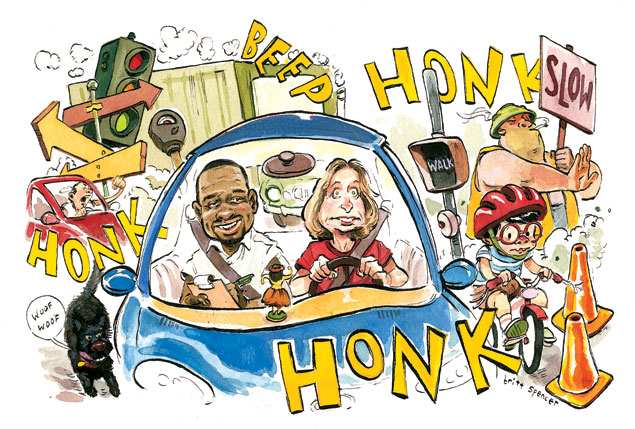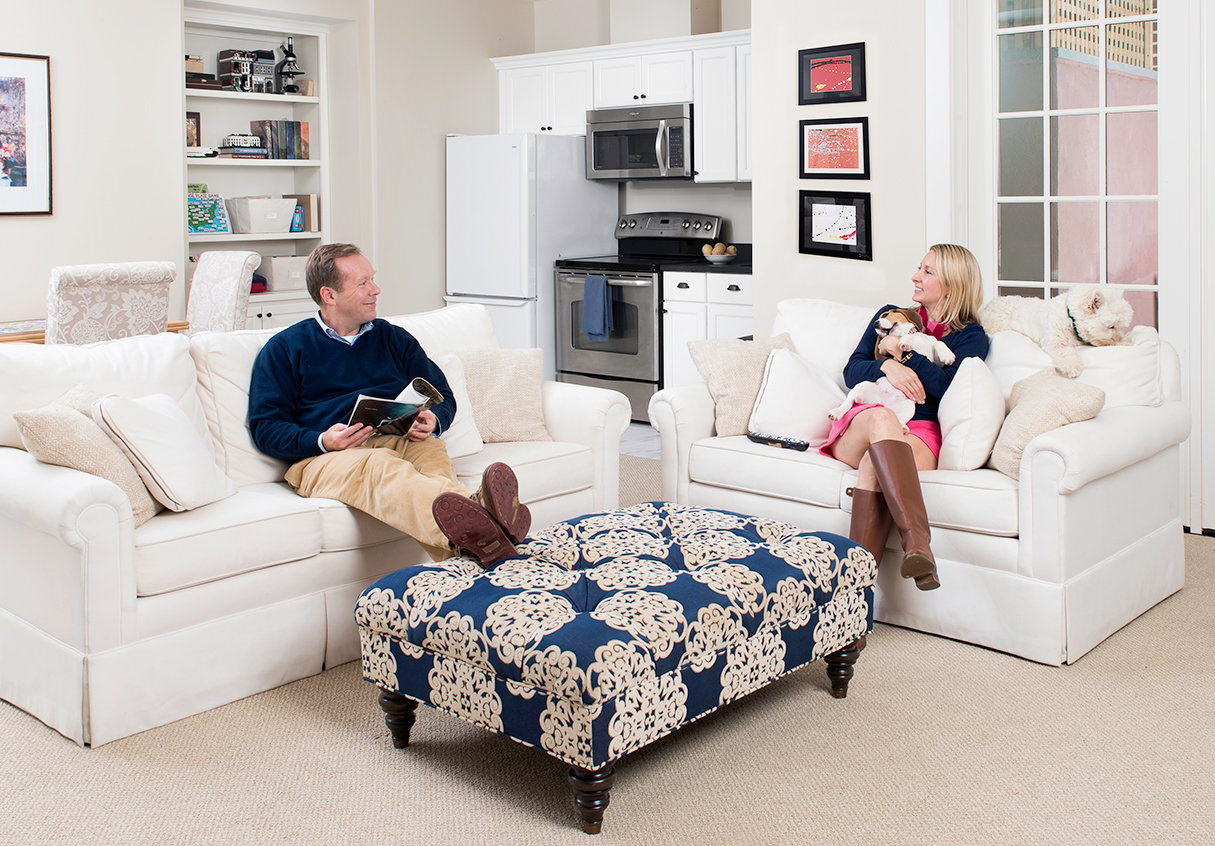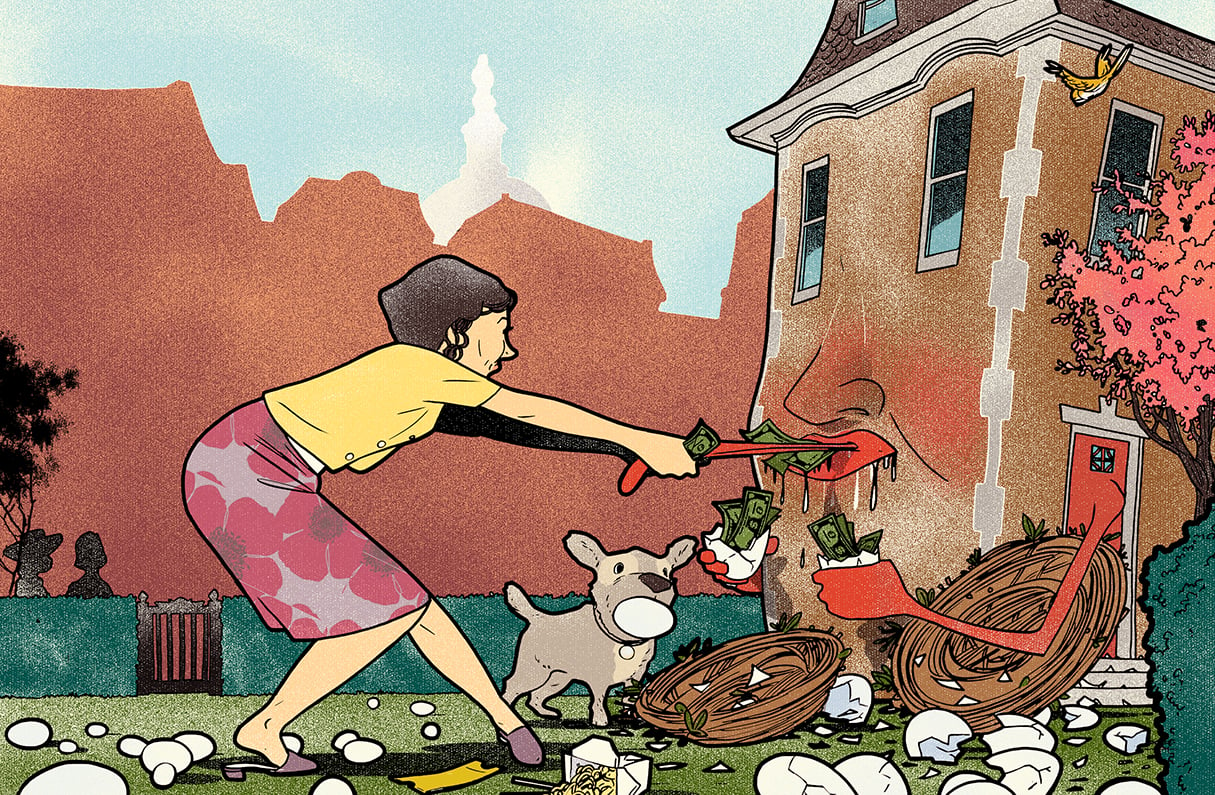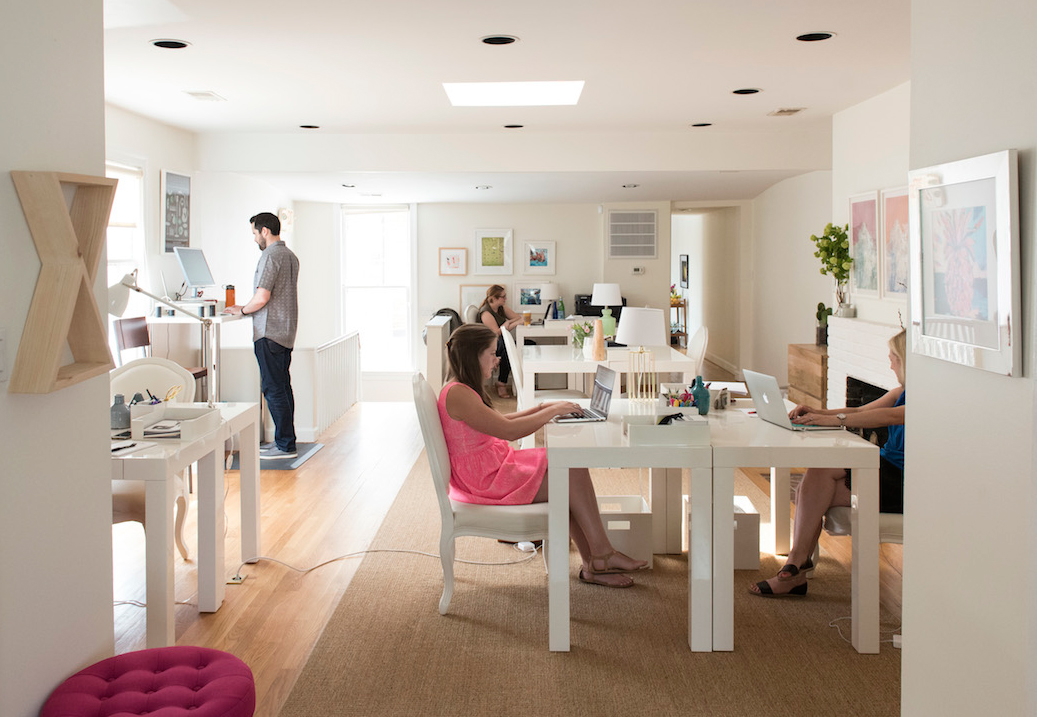I pull up alongside the blue Chevy Caprice, creeping forward until I see its back fender in my rear passenger window. As soon as I do, I hit the brake, shift into reverse, turn my wheel 180 degrees, and eyeball my passenger, who gives an encouraging nod.
It’s not the Caprice that has me sweating bullets. It’s the gray Mercedes in my driver’s-side mirror—the one parked behind the spot I’m trying to squeeze into.
As I continue backing up in slow motion, I keep checking my side mirror until I see the Mercedes’s front as well as a glimpse of the curb. Then I forget what to do. Is it time to straighten my wheel or turn it in the other direction? Should I be looking in my side mirror or my rearview? I freeze, holding the steering wheel in a death grip. My companion, who has so far been communicating with affirmative head bobbing, begins to shake his head.
No, he shakes—no, no, no.
“I’m headed straight for the Mercedes!” I say in a panic.
“Just take your time,” he says, offering no further help. I must do this alone. Everything has led up to this moment.
After 15 agonizing minutes, cranking my wheel one way and the other, backing up so slowly that my maneuvering should be captured with time-lapse photography, I finally nestle into my spot.
“Let’s get out of here,” my passenger says. “People will start to get suspicious if we spend any more time in front of their houses.”
Before we drive off, I wonder: What am I doing here?
I haven’t been behind the wheel of a car since moving to Washington nearly a decade ago and witnessing the mayhem that is the Beltway. I’m almost eight months pregnant, and though this baby isn’t even born yet, he’s already changing my life. (Actually, being 45 years old and pregnant was life-altering in its own way.) Before my pregnancy, taking up driving again was always a vague plan, like learning to speak Italian. It was why I always renewed my DC license. But once it dawned on me that mothers do most of the carting and depositing of kids, I realized I’d no longer be able to avoid the inevitable.
Even on foot, I’m not the most spatially aware person. I often hit my head on low branches or whack my hip into the corners of tables as I make my way through a restaurant.
Back when I did drive, I was the person in the slow lane. I gave extra-wide berth to bicyclists. My car, a family hand-me-down, advertised my abilities with a vanity plate that read grandma.
The way I saw it, “Grandma” had no business cruising the mean streets of Washington, where, according to a 2011 study by Allstate, drivers have more auto wrecks than in any other city in the country. Drivers in the Washington area average an accident every 4.8 years, while the national average is one every ten. Given all this, there was no way I was getting behind the wheel again without a crash course in driving.
All roads led to Peter Dibiaocha, the owner and sole instructor of Rock Driving School. I found him the way I find most things: Google. There was something comforting about his website, which featured a soft-focus photo of autumnal trees lining what looked like the Mall. He specialized in refresher courses. “We help licensed drivers OVERCOME all fears due to nervousness or lack of confidence behind the wheel,” the site said.
I composed an e-mail to the address listed on the site: “I am a middle-aged woman with a valid driver’s license and a baby on the way, and I’m scared to death to get behind the wheel. Especially in Georgetown, where the streets are so narrow and the drivers are such jerks.”
I felt a therapeutic release in every keystroke. I was freaked out enough about becoming a mother, but at least I would soon be a mother who could drive without freaking out.
“On a scale of one to ten, how scared to death are you?” Dibiaocha asks when he calls me later that evening. His voice is deep and carries an accent I can’t place.
“Seven.” I’m actually a ten, but I don’t want to scare him off.
“Okay,” he says, “no problem. We can work with that.”
I hang up, write a check for $350 for three behind-the-wheel lessons, and draw up my personal “challenge list”: all the treacherous streets, parkways, and circles I want to conquer.
“I think I’m a ten now,” I tell Peter when he pulls up in a Toyota Corolla for our first lesson.
“It’s okay!” he laughs. “No problem.”
Easy for him to say. It’s 8 am on a Tuesday and my street in Georgetown is not only under construction—with orange cones designating improvised lanes and men in hardhats milling about—but it’s also loaded with hotheads trying to get to work on time.
Fortunately for me, Peter drives us out of the mess. He’s dressed in beige cargo shorts and a blindingly white T-shirt—what will be his uniform for all of our lessons—and is so tall that his knees practically straddle the steering wheel. He shows me his laminated identification card, which reads professional instructor, and asks to see my driver’s license. To become an instructor, he explains, he had to pass a written and driving test, keep his license up to date, and submit to a yearly criminal-background check.
“Do you have our route mapped out?” I ask as we cross the Dumbarton Bridge toward Dupont Circle.
“We’ll see how we start, and then we’ll know how we end,” he says.
I take this to mean he’ll see how many cars I almost hit before deciding exactly where he’ll drop me off on the side of the road.
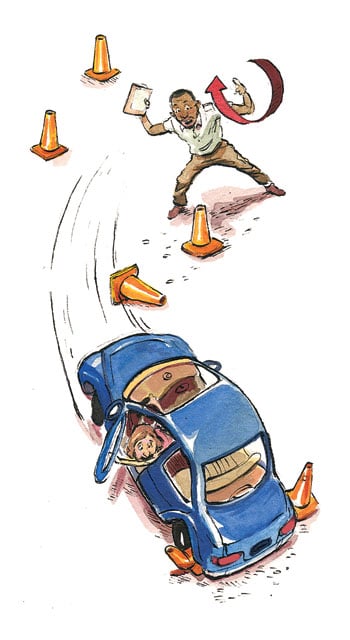
We drive up 16th Street and enter the empty parking lot of Carter Barron Amphitheatre. I have a flashback to when I was 16 and my father took me to a similar lot on a snowy day in Connecticut. My first move was to drive his Cadillac DeVille into a snowbank. He was making me so nervous that I put the car into drive instead of reverse.
“Now it’s your turn,” says Peter, unbuckling his seat belt and politely wiping down the steering wheel with a cloth.
Once I assume my place in the driver’s seat, Peter helps me get the seat belt positioned around my belly. During the ride over, he told me that his wife, who lives in his native Nigeria, is six months pregnant, also with a boy.
“Okay, press the brake and put the car in drive,” he says. It’s been so long since I’ve done either of these things that I have to stop and think about which pedal is the gas and which is the brake.
I edge around the parking lot, taking orders from Peter: “Make a right at the end of this aisle,” “Stop at the end of that parking space.” Peter tells me he brought me here to assess my driving skills and see how well I maneuver the car, and even though I feel self-conscious performing this circuitous ride over and over like some sort of show pony, my muscle memory returns and I begin to get a feel for the car. Peter suggests we take our act on the road.
For the next hour, we hit the challenge-list highlights, beginning with the lane-jockeying madness that is 14th Street and continuing to the Calcutta-like congestion on U Street. I feel like a gopher at the wheel, my head jerking in every direction trying to avoid the barreling UPS truck on my left, the jaywalking mothers pushing strollers on my right, and the bicyclists flying between traffic lanes like they’re dodging bullets.
“Look out for that pedestrian!” Peter cries, and I notice, way ahead on 14th, someone just stepping into a crosswalk. “The light is going to change in nine seconds—can you make it?” he asks, eyeing a countdown clock on a crossing sign. He senses fire engines minutes before sirens sound. And he seems to know what I’m going to do long before I do. “Make sure you use your signal,” he says, before the thought of changing lanes occurs to me.
Only once does Peter grab the wheel from me—when a biker appears out of nowhere on 14th Street and, to avoid hitting him, I swerve and nearly sideswipe the car in the next lane. Peter’s move is so calm and graceful that it takes me a moment to realize I almost caused an accident. I’m both embarrassed and grateful that Peter is in the car with me to witness—and cover for—such an amateur move.
“Do you happen to have a student driver sign we could put in the back window?” I ask, regaining the wheel.
“How many times has someone beeped at you today?” Peter says, turning to look at me.
“Zero times.”
“If I put that sign in the back window, just wait and see how many people will beep,” he says. A student-driver sign, he explains, would label me as inexperienced. “They will beep because they will assume you will do something wrong.”
Which happens to be pretty similar to what I expect now that I’m expecting. I haven’t changed a diaper since I was a teenage babysitter. I can’t recall the last time I even held an infant. And though I have a stack of baby books—castoffs from friends whose kids are practically driving age themselves—I can’t find the answers I truly need. Like how do I handle being the oldest mom on the playground?
As I drive back home, I ask Peter who is easier to teach, younger or older clients.
“Younger,” he says. “They have no fear. Whatever I ask them to do, they just do it.”
“Adults have seen a lot of life,” he says. “They know what can happen if they make a mistake.”
And clients like me? “Adults have seen a lot of life,” he says. “They know what can happen if they make a mistake.”
Back in Nigeria, Peter was a pastor, and I think about his role as a teacher—both here and there—and what sort of lessons he’ll impart to me during our time together.
“You did pretty good,” he says as I pull the car into the driveway across from my apartment building. I can’t tell whether it’s because he’s been sweating nervously the whole ride back or because he’s offering me some sort of blessing, but Peter circles his forehead with the palm of his hand and says simply, “Believe.”
Part of his role as a pastor, he tells me, was to inspire confidence in others. He says Peter means “rock” in the Bible, hence the name of his driving school. And after two hours in his calm and steady presence, I have enjoyed some small victories. “I made it home in one piece,” I e-mail my husband, Karl. “And managed not to hit anyone.”
But I still can’t imagine being alone in a car with a baby. I won’t have anyone to grab the wheel when I drift into another lane or to tell me how many seconds I have left on the crossing sign. Our new pediatrician is in DC’s Spring Valley neighborhood, about four miles from our home, and the thought of negotiating not one but two traffic circles to get there makes me want to find a new doctor. One within stroller-pushing distance.
But if I can’t handle driving a few miles up Massachusetts Avenue, how will I tackle the even more unfamiliar roadways of motherhood? For all the years my husband and I spent trying to have a child, it seemed that all roads led there. But now that we’re almost at our destination, I’m not sure I’m ready to unpack. My days have become a series of what-if’s: What if I regret giving up the quiet life my husband and I had carved out for ourselves? What if I’m still changing diapers when I’m 50? What if this baby doesn’t like me? Worse, what if I don’t like him?
“I want to go on the Beltway,” I tell Peter when he picks me up the next morning.
“I like that you want to challenge yourself,” he says as I take the wheel. “But do you know how to get there?”
It turns out Peter isn’t very familiar with Virginia’s roads. I decide to take the same route Karl and I take to get to our sonogram appointments in Rockville, but I immediately make a wrong turn off Rock Creek Parkway (another check off my challenge list) and land us on Route 66 instead of the GW Parkway. We’re stuck in bumper-to-bumper traffic. I look over at Peter, who smiles at me and stares happily out the window. I have no idea how to get us back on track, but his relaxed state reassures me.
“I guess we’re having the real DC experience now,” I say.
Sitting in traffic allows us time to talk. When we inch by some construction near the exit for Glebe Road, Peter looks at the men in their orange vests and says, “That was my first job when I moved to Washington. I held the stop sign, moved cones, drove a truck, whatever they told me to do.” He lasted until the temperature dropped. “I don’t like the cold,” he says.
He next took a job doing inspections at the Department of Motor Vehicles. Besides being a pastor in Nigeria, he had also been a mechanic, and his new job suited him. His coworkers, however, did not. “I didn’t like the way they treated customers,” he says. He opened his driving school in 2007 and left the DMV the next year. He typically teaches three students a day. “Any more,” he says, “would be too much.”
Especially when one of his students gets lost in Northern Virginia. Eventually, we see a sign for 495. “I knew I could find it!” I cheer, and we head north toward Baltimore. “Am I on the inner or the outer loop?” I ask.
“I don’t know,” he says, craning his neck around, maybe hoping for a sign, either physical or spiritual.
“I think I’m on the inner loop,” I say. I begin to feel like I’m in the greatest buddy movie of all time. The pregnant lady and the Nigerian pastor try to find Rockville and end up in Maine. Instead of panicking, I enjoy the comedy. I’m on a loop after all—whether inner or outer—so I’m bound to end up back where I belong.
After a while, the road divides and I see a sign for I-270. “I did it!” I shout. “This is how my husband and I get to our sonogram appointments. I know where I am!” Though I’ve been driving in the slow lane, my heart is racing.
“Can you get us back home?” Peter asks.
I can. And I do. But first I want to cross one more thing off the challenge list.
Back in town, I head to Wisconsin Avenue and pick up Massachusetts by Washington National Cathedral. After the challenges of finding the Beltway, getting to Spring Valley Pediatrics is a breeze.
“That was easy,” I say, turning around in the parking lot and heading home. I can finally see myself driving my baby here for checkups, and I even take note of a few nearby cafes where I can imagine us enjoying an afternoon cookie.
“So,” Peter says when I pull up in front of my building, “what other challenges do you have for yourself?”
I’ve saved the ultimate test for last. As I give up the driver’s seat to Peter, I shake his hand goodbye and say, “Do you think you can teach me how to parallel-park in two hours?”
I’ve saved the ultimate test for last. As I give up the driver’s seat to Peter, I shake his hand goodbye and say, “Do you think you can teach me how to parallel-park in two hours?”
I’d like to say that after my last lesson, after returning to where it all began in the Carter Barron parking lot, after Peter gave me a visual demonstration using three empty Tic Tac boxes, after I slammed into the orange traffic cones he set up to represent parked cars, and after I took an ungodly amount of time trying not to hit the Mercedes, I can now parallel-park like a champ.
But that would be a lie.
I am still a terrible parallel-parker. I have no feel for it, as evidenced by how often I found myself parked three feet from the curb.
“Straighten your wheel,” Peter told me more than once.
“It is straight,” I’d say.
Then he’d lean over, grab the wheel, and crank it as if tightening a vice.
But by the end of my time with Peter, parallel-parking wasn’t really the point. The fact that I was no longer afraid to try it was. Actually, there were a lot of things I was no longer afraid to try.
As I drove us back to my apartment, I asked Peter if he had any advice.
“You overthink things,” he said. “You tell yourself, ‘This place is dangerous’ or ‘I’m scared of this street or that street.’ But once you actually get there, you realize that the fear that worried you is not the reality you meet.”
Hugging him goodbye, I realized the same could be said about motherhood.
Leo was born on August 1, and—to use another vehicular term—I’m finding motherhood just like riding a bike. Sure, I’ve fallen a few times. Or rather, Leo has—once even on his head. But just as Peter wisely noted, the fear that worried me didn’t follow me home from the maternity ward.
I’d like to say I drove home from the hospital that day. It took me just as many months to get back behind the wheel as it did to carry this child. But when I did, agreeing to drive us back from the pediatrician’s office if my husband drove us there, I can tell you this: We all enjoyed the ride.
Contributing editor Cathy Alter (cathy@cathyalter.com) is the author of “Up for Renewal: What Magazines Taught Me About Love, Sex, and Starting Over.”
This article appears in the June 2012 issue of The Washingtonian.

